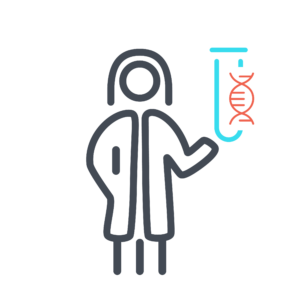MAOA-Related Syndrome

Table of contents
- What is MAOA-related syndrome?
- Key Role
- Symptoms
- What causes MAOA-related syndrome?
- Why does my child have a change in the MAOA gene?
- What are the chances that other family members of future children will have MAOA-related syndrome?
- How many people have MAOA-related syndrome?
- Do people who have MAOA-related syndrome look different?
- How is MAOA-related syndrome treated?
- Behavior and development concerns linked to MAOA-related syndrome
- Medical and physical concerns linked to MAOA-related syndrome
- Where can I find support and resources?
- Sources and References
MAOA-related syndrome is also called Brunner syndrome. For this webpage, we will be using the name MAOA-related syndrome to encompass the wide range of variants observed in the people identified.
What is MAOA-related syndrome?
MAOA-related syndrome happens when there are changes in the MAOA gene. These changes can keep the gene from working as it should.
The MAOA gene is located on the X chromosome, which is one of the sex chromosomes.

Key Role
The MAOA gene plays a key role in the communication between brain cells.
Symptoms
Because the MAOA gene is important for brain activity, many people who have MAOA-related syndrome have:
- Developmental delay
- Intellectual disability
- Learning issues
- Tremor
- Disturbed sleep and night terrors
- Episodic headaches
- Autism
- Attention-deficit/hyperactivity disorder (ADHD)
- Antisocial behavior
- Behavioral issues and temper tantrums
Brunner syndrome mostly affects males, but some females might have symptoms.
What causes MAOA-related syndrome?
MAOA-related syndrome is a genetic condition, which means that it is caused by variants in genes. Our genes contain the instructions, or code, that tell our cells how to grow, develop, and work. Genes are arranged in structures in our cells called chromosomes. Chromosomes and genes usually come in pairs, with one copy from the mother, from the egg, and one copy from the father, from the sperm.
We each have 23 pairs of chromosomes. One pair, called the X and Y chromosomes, differs between biological males and biological females. Biological females have two copies of the X chromosome and all its genes, one inherited from their mother and one inherited from their father. Biological males have one copy of the X chromosome and all its genes, inherited from their mother, and one copy of the Y chromosome and its genes, inherited from their father.
In most cases, parents pass on exact copies of the gene to their child. But the process of making the sperm and egg is not perfect. A variant in the genetic code can lead to physical issues, developmental issues, or both.
The MAOA gene is located on the X chromosome, so variants in this gene can affect biological males and biological females in different ways. Biological males who have variants in this gene will likely have MAOA-related syndrome.
Biological females who have variants in this gene may or may not have symptoms of MAOA-related syndrome. Biological females who have one working copy of the gene and one non-working copy are considered to be ‘carriers’. Even if a biological female does not have signs or symptoms of the syndrome, they can pass it along to their children.
X-linked recessive conditions
Research shows that MAOA-related syndrome is often the result of an inherited variant in MAOA. This means that MAOA-related syndrome happens because the genetic variant was passed down from a biological female parent. Biological females that carry the MAOA variant usually do not have symptoms, but sometimes they might.
Sometimes it results from a spontaneous variant in the MAOA gene in the sperm or egg during development. When a brand new genetic variant happens in the genetic code is called a ‘de novo’ genetic variant. The child can be the first in the family to have the gene variant.
X-Linked Recessive Genetic Syndrome
Why does my child have a change in the MAOA gene?
No parent causes their child’s MAOA-related syndrome. We know this because no parent has any control over the gene changes that they do or do not pass on to their children. Please keep in mind that nothing a parent does before or during the pregnancy causes this to happen. The gene change takes place on its own and cannot be predicted or stopped.
What are the chances that other family members of future children will have MAOA-related syndrome?
Each family is different. A geneticist or genetic counselor can give you advice on the chance that this will happen again in your family.
The risk of having another child who has MAOA-related syndrome depends on the genes of both biological parents.
- Biological females who have a variant in the MAOA gene and are pregnant with a daughter have a 50 percent chance of passing on the same genetic variant and a 50 percent chance of passing on the working copy of the gene.
- If they are pregnant with a son, the child has a 50 percent chance of inheriting the genetic variant and the syndrome.
For a symptom-free brother or sister of someone who has MAOA-related syndrome, the sibling’s risk of having a child who has MAOA-related syndrome depends on the sibling’s genes and their parents’ genes.
- If neither parent has the same genetic variant causing MAOA-related syndrome, the symptom-free sibling has a nearly 0 percent chance of having a child who would inherit MAOA-related syndrome.
- If the biological mother has the same genetic variant causing MAOA-related syndrome, and the symptom-free daughter has the variant, the symptom-free daughter’s chance of having a son who has MAOA-related syndrome is 50 percent.
For a person who has MAOA-related syndrome, the risk of having a child who has the syndrome is about 50 percent.

How many people have MAOA-related syndrome?
As of 2025, about 23 people with MAOA-related syndrome have been identified in medical research.

Do people who have MAOA-related syndrome look different?
Most people who have MAOA-related syndrome do not look different. Some people might look like they are blushing (have a flushed appearance).

How is MAOA-related syndrome treated?
Scientists and doctors have only just begun to study MAOA-related syndrome. At this point, there are no medicines designed to treat the syndrome. A genetic diagnosis can help people decide on the best way to track the condition and manage therapies. Doctors can refer people to specialists for:
- Physical exams and brain studies
- Genetics consults
- Development and behavior studies
- Other issues, as needed
A developmental pediatrician, neurologist, or psychologist can follow progress over time and can help:
- Suggest the right therapies. This can include physical, occupational, speech, or behavioral therapy.
- Guide individualized education plans (IEPs).
Specialists advise that therapies for MAOA-related syndrome should begin as early as possible, ideally before a child begins school.
If seizures happen, consult a neurologist. There are many types of seizures, and not all types are easy to spot. To learn more, you can refer to resources such as the Epilepsy Foundation’s website: www.epilepsy.com/learn/types-seizures.

This section includes a summary of information from published articles. It highlights how many people have different symptoms. To learn more about the article, see the Sources and References section of this guide.
Behavior and development concerns linked to MAOA-related syndrome
Speech and learning
Males with MAOA-related syndrome had developmental delays or intellectual disabilities, and some people had speech delay or articulation issues.
- 22 out of 23 people had developmental delays or intellectual disabilities (96 percent)
Behavior
People with MAOA-related syndrome had behavioral issues, such as aggression, impulsivity, attention-deficit/hyperactivity disorder (ADHD), and autism or features of autism.
Brain
Some people with MAOA-related syndrome had neurological issues, including seizures, night terrors, developmental coordination disorder, clumsiness, and headaches.

Medical and physical concerns linked to MAOA-related syndrome
Other medical features
Few people with MAOA-related syndrome had high cholesterol (hypercholesterolemia) and were overweight. Many people had tremors.

Where can I find support and resources?
Simons Searchlight
Simons Searchlight is an online international research program, building an ever growing natural history database, biorepository, and resource network of over 175 rare genetic neurodevelopmental disorders. By joining their community and sharing your experiences, you contribute to a growing database used by scientists worldwide to advance the understanding of your genetic condition. Through online surveys and optional blood sample collection, they gather valuable information to improve lives and drive scientific progress. Families like yours are the key to making meaningful progress. To register for Simons Searchlight, go to the Simons Searchlight website at www.simonssearchlight.org and click “Join Us.”
- Learn more about Simons Searchlight: www.simonssearchlight.org/frequently-asked-questions
- Simons Searchlight webpage with more information on MAOA: www.simonssearchlight.org/research/what-we-study/MAOA
- Simons Searchlight MAOA Facebook community: https://www.facebook.com/groups/maoa

Sources and References
The content in this guide comes from a published study about MAOA-related syndrome.
- Minniti, M. L., Kalantari, S., Pasca, L., Bruno, S., Arceri, S., Novello, E., Giorgio, E., Rizzo, V., Borgatti, R., … & Sirchia, F. (2024). Expanding the phenotype of Brunner syndrome from childhood to adulthood: Description of the second pediatric patient and his mother. American Journal of Medical Genetics Part A, 194(1), 82-87. https://pubmed.ncbi.nlm.nih.gov/37750385/
- Palmer, E. E., Leffler, M., Rogers, C., Shaw, M., Carroll, R., Earl, J., Cheung, N. W., Champion, B., Hu, H., … & Field, M. (2016). New insights into Brunner syndrome and potential for targeted therapy. Clinical Genetics, 89(1), 120-127. https://pubmed.ncbi.nlm.nih.gov/25807999/
- Ünsel-Bolat, G., Turan, S., & Bolat, H. (2024). A novel MAOA gene variant: Brunner syndrome, a rare syndrome, is associated with a wide range of psychiatric symptoms. International Journal of Developmental Neuroscience, 84(8), 972-976. https://pubmed.ncbi.nlm.nih.gov/39450862/
